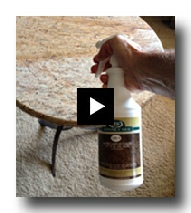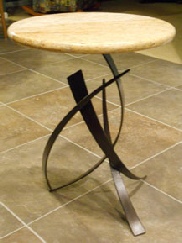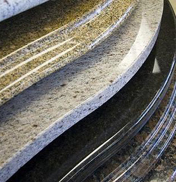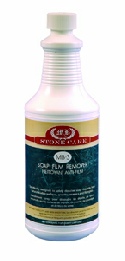Granite care guidelines are seldom provided when you purchase stone countertops. Or the instructions you’re given for granite countertop care came from an installer or helper who has never been properly trained in the science of stone care.
This isn’t a slam against fabricators and installers, it’s just a fact. Wouldn’t it be nice to have an owners manual to show you proper granite countertop care and how to keep your stone tops looking great for years?
Well . . . here is the official insiders guide to countertop granite care.
Click on Professional Granite Care Products to see the only cleaners and sealer for your stone counters that we have used on literally thousands of granite countertops. See limestone countertops care if you have limestone in your kitchen.
See Kitchen Remodeling Help for tips and advice to remodel your kitchen.
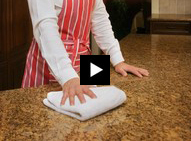
How you should clean granite
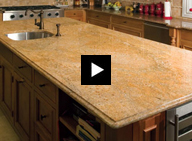
How you should seal granite
Visit the granite care video instructions page
Care and Cleaning of Your Natural Stone Tops
The natural stone you have purchased for your home or office is an investment that will give you many years of beautiful service.
Simple care and maintenance will help preserve your stone’s beauty for generations to come. This guide offers routine cleaning guidelines as well as procedures for stain removal should it become necessary.
Care and Precautions
Use coasters under all glasses, particularly those containing alcohol or citrus juices. Many common foods contain acids that can dull or etch the surface of many stones.
Use trivets or mats under hot dishes and placemats under china, ceramics, silver, or other objects that can scratch the surface.
Here’s how real granite pros determine the need for sealing –
How to clean granite countertops
The simplest means of caring for granite is cleaning. Clean stone surfaces with a neutral cleaner, stone soap, or mild dishwashing detergent and warm water. Too much cleaner or soap may leave a film. Do not use products that contain lemon, vinegar, or other acids on marble or other calcareous stones. Rinse the surface thoroughly after washing with the soap. Do not use scouring powders or creams; these products contain abrasives that may scratch the stone. Tops may need to have a penetrating sealer applied.
If you have cleaned your granite tops with dish soap, you can restore the granite shine with MB-
As a fabricator and installer, we always degreased countertops and gave them their final cleaning with denatured alcohol. Denatured alcohol, it turns out, does wonders for cleaning granite and cutting through film buildup on your counters. The result is the original shiny surface.
Cleaning granite countertops with Windex can be a problem. You should only use specialized cleaners, not Windex or ammonia. The best performing product we have found is MB-
Know Your Stone
Natural stone can be classified into two general categories depending on its composition: siliceous or calcareous. Knowing the difference is critical when choosing cleaning products. Siliceous stone is composed mainly of silica or quartz-
Calcareous stone is composed mainly of calcium carbonate. It is sensitive to acidic cleaning products and may require different cleaning procedures than siliceous stone. Examples of calcareous stone include marble, travertine, limestone, and onyx.
Spills and Stains
Blot the spill with a paper towel immediately. Don’t wipe the area, it will spread the spill. Flush the area with plain water and mild soap and rinse several times. Dry the area with a soft cloth. Repeat as necessary. If the stain remains, refer to the following sections in this guide. See Granite Stain Removal.
Types of Stains and Cleaning Actions Needed
Oil-
Organic (coffee, tea, fruit, tobacco, paper, food, urine, leaves) May cause a pinkish-
Metal (iron rust, copper, bronze) Iron or rust stains are orange to brown in color and follow the shape of the staining object. Copper and bronze stains appear as green or muddy-
Biological (algae, mildew, lichens, moss, fungi) Clean with dilute (1/2 cup in a gallon of water) ammonia OR bleach OR hydrogen peroxide. DO NOT MIX BLEACH AND AMMONIA! THIS COMBINATION PRODUCES A TOXIC AND LETHAL GAS!
Ink (magic marker, pen, ink) Clean with bleach OR hydrogen peroxide (light colored stone only!) OR lacquer thinner or acetone (dark stones only!)
Paint. Small amounts can be removed with lacquer thinner or scraped off carefully with a razor blade. Heavy paint coverage should be removed only with commercial “heavy liquid” paint stripper available from hardware stores and paint centers. These strippers normally contain caustic soda or lye. Do not use acids or flame tools to strip paint.
Paint strippers can etch the stone surface. Follow the manufacturer’s directions taking care to flush the area thoroughly with clean water. Protect yourself with rubber gloves and eye protection. Work only in well ventilated areas. Normally, latex or acrylic paint will not cause staining. Oil based paints, linseed oil, putty, caulks and sealants may cause oily stains.
Scratches and Nicks. Surface scratches may be buffed with dry 0000 steel wool. Deeper scratches and nicks should be repaired and re-

Does granite need to be sealed?
Professional Granite Care Guide
Best Granite Sealer
Need to find a really good granite countertop fabricator and installer?
Making and Using a Poultice
Sometimes stone top care requires removing stains with a poultice. A poultice is a liquid cleaner or chemical mixed with a white absorbent material to form a paste about the consistency of peanut butter.
The poultice is spread over the stained area to a thickness of about ½” with a wood or plastic spatula, covered with plastic, and left to work for 24 to 48 hours. The liquid cleaner or chemical will draw out the stain into the absorbent material. Poultice procedures may need to be repeated to completely remove a stain.
Poultice Materials
Poultice materials include kaolin, fuller’s earth, whiting, diatomaceous earth, powdered chalk, white molding plaster or talc. Approximately one pound of prepared poultice material will cover one square foot.
Do not use whiting or iron-
Oil Based Stains
Poultice with baking soda and water OR one of the powdered poultice materials and mineral spirits.
Organic Stains
Poultice with one of the powdered poultice materials and 12% hydrogen peroxide (hair bleaching strength) OR use acetone instead of the hydrogen peroxide.
Iron Stains
Poultice with diatomaceous earth and a commercially available rust remover. Rust stains are particularly difficult to remove and may require a professional.
Copper Stains
Poultice with one of the powdered poultice materials and ammonia. Biological Stains. Poultice with dilute ammonia OR bleach OR hydrogen peroxide. DO NOT MIX BLEACH AND AMMONIA! THIS COMBINATION PRODUCES A TOXIC AND LETHAL GAS!
Applying the Poultice
Prepare the poultice. If using powder, mix the cleaning agent or chemical to a thick paste the consistency of peanut butter. If using paper, soak in the chemical and let drain. Don’t let the liquid drip. Wet the stained area with distilled water.
Apply the poultice to the stained area about ¼ to ½ inch thick and extend the poultice beyond the stained area by about one inch. Use a wood or plastic scraper to spread the poultice evenly. Cover the poultice with plastic and tape the edges to seal it. Allow the poultice to dry for about 24 to 48 hours.
The drying process is what pulls the stain out of the stone and into the poultice material. After about 24 hours, remove the plastic and allow the poultice to dry. Remove the poultice from the stain. Rinse with distilled water and buff dry with a soft cloth.
Use the wood or plastic scraper if necessary to lift the poultice off the stain. Repeat the poultice application if the stain is not removed. It may take up to five applications for difficult stains.
Care of granite countertops is simple and not time consuming. You should never even need to deal with granite stains and your natural stone tops will look great year after year.
Restore the shine to your granite counters
Designed to safely dissolve soap film and hard water deposits from natural marble, granite, ceramics, and fiberglass.
Use MB-
What’s the best sealer for granite countertops?
Should I use special granite cleaner for my countertops?
Download the Granite Countertop Owner’s Manual
Can Angie’s List help me find qualified granite countertop fabricators in my area?
Will a UV light wand make my granite counters cleaner?
See Cleaning Stainless Steel Sinks for advice and tips to keep your sinks looking new
See Granite Repair for tips and resources to fix damaged and chipped tops
Radon From Granite Countertops –
Remodeling Cincinnati –
Return from Granite Care to Homepage


